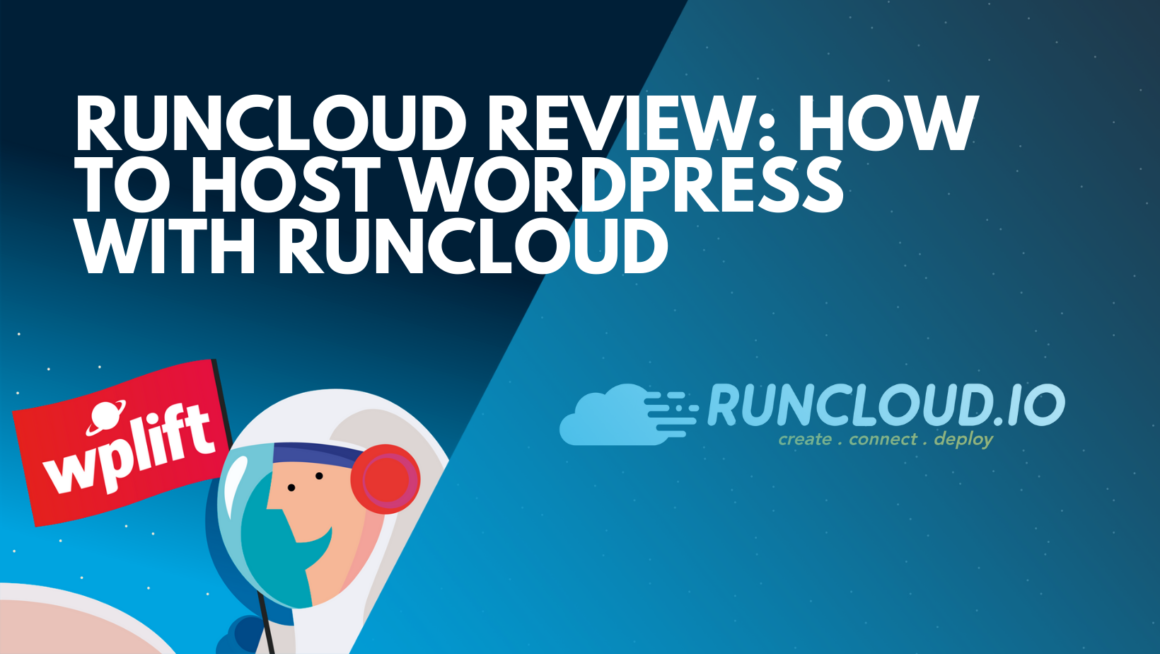Interested in using RunCloud to host your WordPress site in the cloud with a provider like DigitalOcean, Linode, Vultr, and more?
Cloud VPS hosting offers an incredibly affordable way to host high-performing WordPress sites. Basically, you can get the page load times of a managed WordPress host for a fraction of the cost.
However, the problem has always been that cloud hosting is way too complicated for regular users. Unless you’re a developer, setting up and maintaining your own cloud server is out of reach. At least it was…
RunCloud (and similar tools) changes that. With RunCloud, even regular users can set up and benefit from cloud WordPress hosting. And to prove that, I’m going to show you exactly how to do it because…well, I’m definitely not a WordPress developer! I’m just a regular guy who likes to play around with WordPress. So if I can set this up, so can you.
This is our third post in a series of guides on how to self-host WordPress in the cloud without being a developer. If you like what you see, you’ll also want to check out our other guides in this space:
Note – as with all our posts in this space, it’s important to remind you that I am not a developer. I’m writing all of these posts from the perspective of regular WordPress end users, so you might place a different emphasis on certain features/interface elements if you’re a developer. That’s fine – different strokes for different folks. This is for us, lowly mortals.
RunCloud Review: What Does RunCloud Do?
Unlike SpinupWP and GridPane, two similar tools that we’ve previously reviewed, RunCloud is not 100% focused on WordPress. Instead, it works for any PHP application that you might want to host.
However, RunCloud has plenty of dedicated features for WordPress sites, like a companion caching plugin, so WordPress users will feel right at home.
Let’s start the beginning, though, with setting up and provisioning a server.
With RunClud, you pretty much just point it at your cloud hosting and it automatically sets up everything for you to make WordPress run. RunCloud lets you choose between two different tech stacks:
- A hybrid Nginx + Apache stack – Apache will serve dynamic files and Nginx will serve static files. The upside is that you can still use your .htaccess file, which a lot of WordPress users rely on.
- Native Nginx stack – Nginx does everything, which means no .htaccess file (but better performance, especially under scale).
RunCloud will work with pretty much any Linux VPS. However, it has dedicated integrations for some providers that make the process even more streamlined as RunCloud can even create the server for you via the API. This is the case for Digital Ocean, which is what I’ll be using for this tutorial.
Once you have your server, you can easily install WordPress with just a few clicks. From there, you’ll be off to the races with useful tools like free SSL certificates, staging sites, automatic backups, and more.
RunCloud Tutorial: How to Set Up Your First WordPress Site
Now, let’s get into the RunCloud tutorial and I’ll show you how to set up your first server and WordPress site with RunCloud. RunCloud offers a five-day free trial with no credit card required, so you can follow along at zero risks to your wallet. There’s also a limited forever free plan, though it’s not a great option for production sites.
1. Create Your Server
Once you sign up for RunCloud, you’ll be prompted to set up your first server. You can’t have WordPress sites until you have a server to run them on.
RunCloud will work with virtually any Linux cloud provider. However, it has dedicated integrations for some providers which lets it both create and provision the server for you, which offers the simplest setup. These providers are:
- Linode
- DigitalOcean
- Vultr
- Upcloud
- Amazon Lightsail
For example, with DigitalOcean, all you need to do is choose Build Server and enter the API key from your DigitalOcean account (register for a DigitalOcean account if you haven’t already).
Once you’ve added your API key, you’ll click the Build server button to get started:
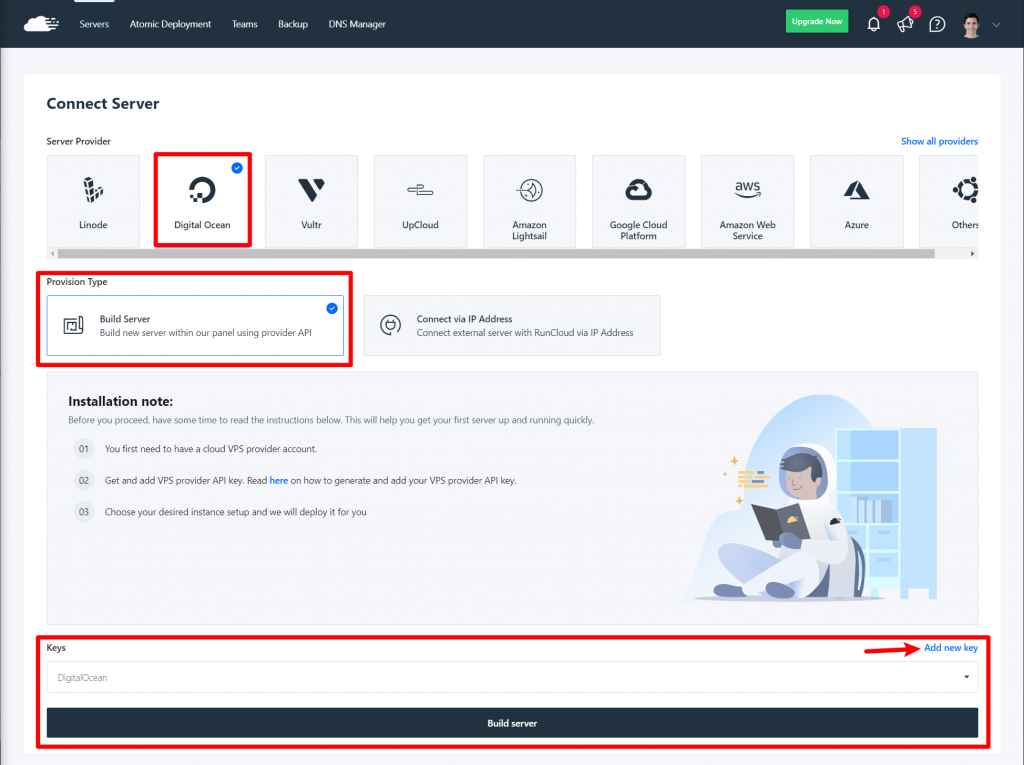
On the next page, you can choose the Linux version, data center, and VPS resources that you want to use. I’m just going to go with the cheapest DigitalOcean droplet for this example:
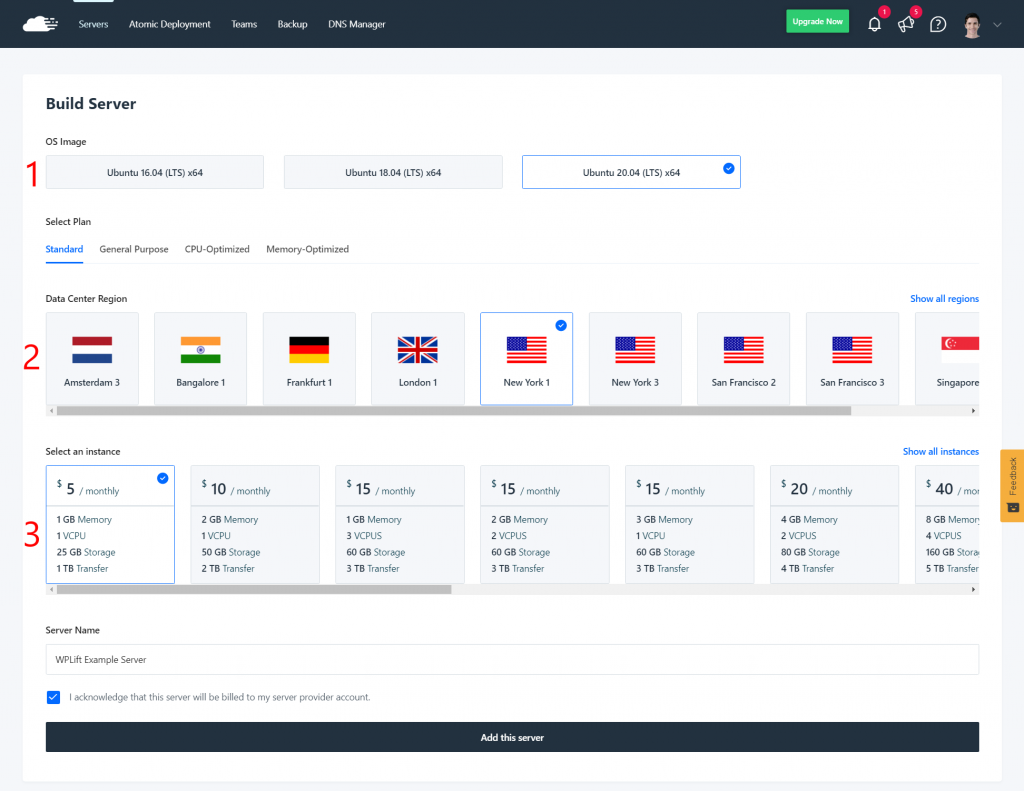
Then, click Add this server.
And that’s it! You now have a working server. Well, you will after RunCloud works its magic. There’s nothing you need to do while that happens, though, so feel free to go grab a coffee and then come back here in about fifteen minutes.
Once it finishes, you should be in your server’s dashboard:
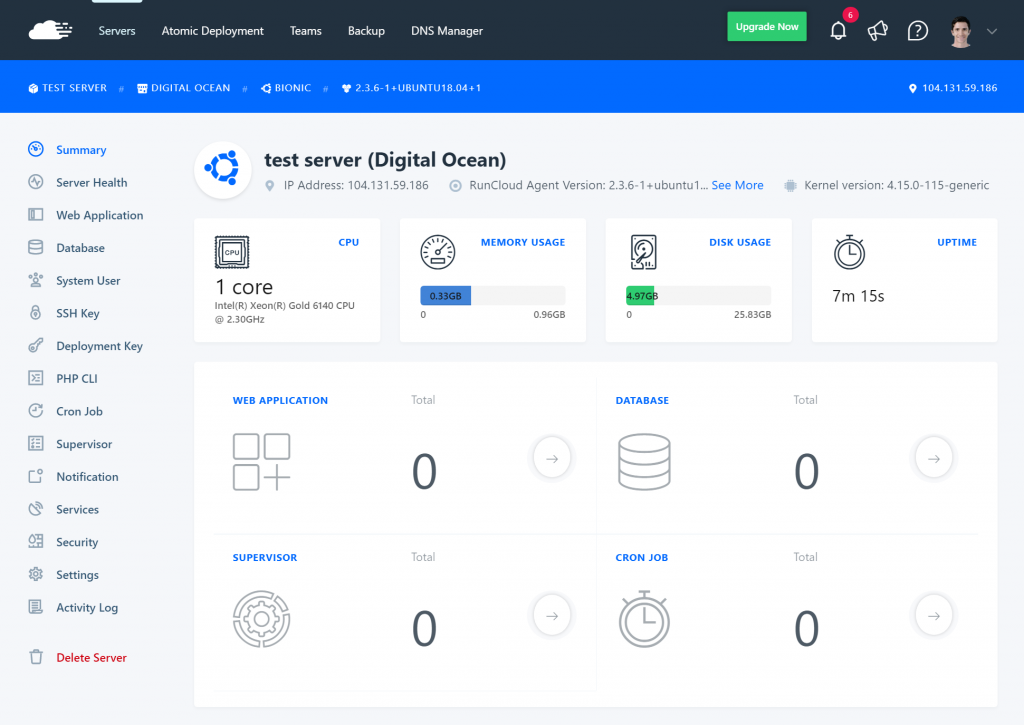
There are a lot of options here, but you don’t really need to mess with anything right now. Let’s move on to installing your WordPress site.
2. Install WordPress
In RunCloud, everything is called an “application”. So one WordPress site equals one application.
To get started, you go to the Web Application tab and then click Create Web App;
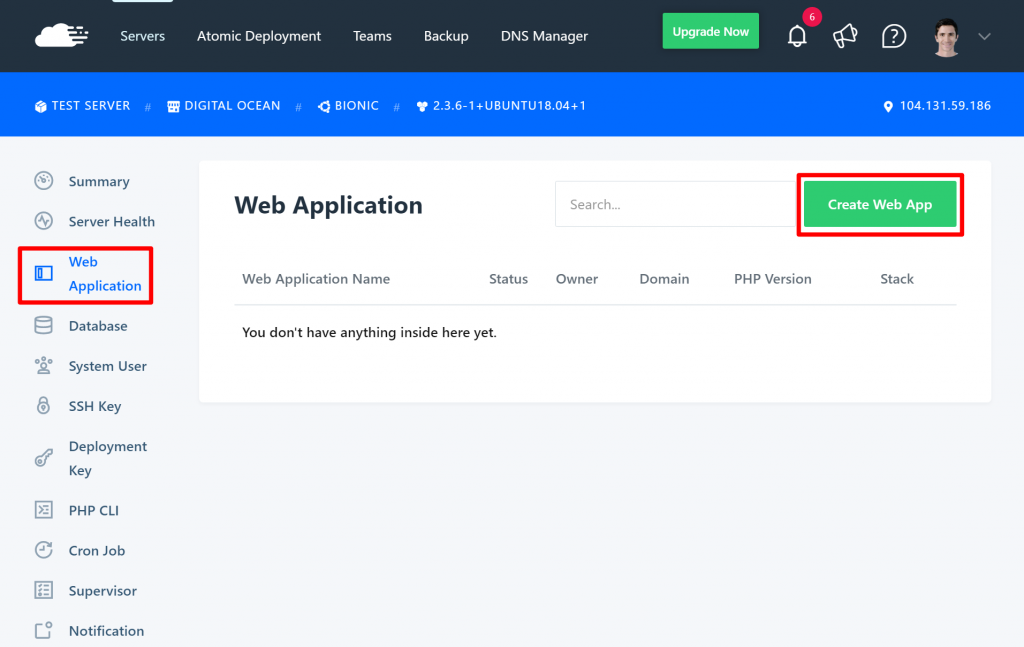
Next, you can select the 1 Click WordPress button to easily install WordPress:
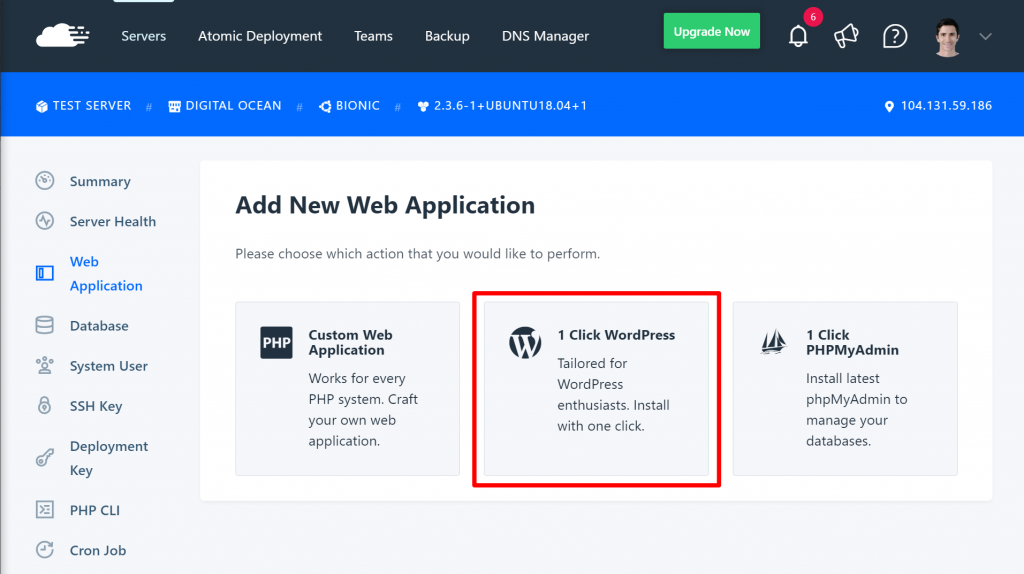
This will launch an interface that’s pretty similar to your standard hosting WordPress autoinstaller, just with a few extra options. One of the most important choices is your Web Application Stack. I recommend the Native Nginx configuration because it’s faster. However, if you want to be able to use .htaccess, you’ll need to choose the Nginx + Apache hybrid. That’s ok…just be aware that you’re sacrificing some performance:
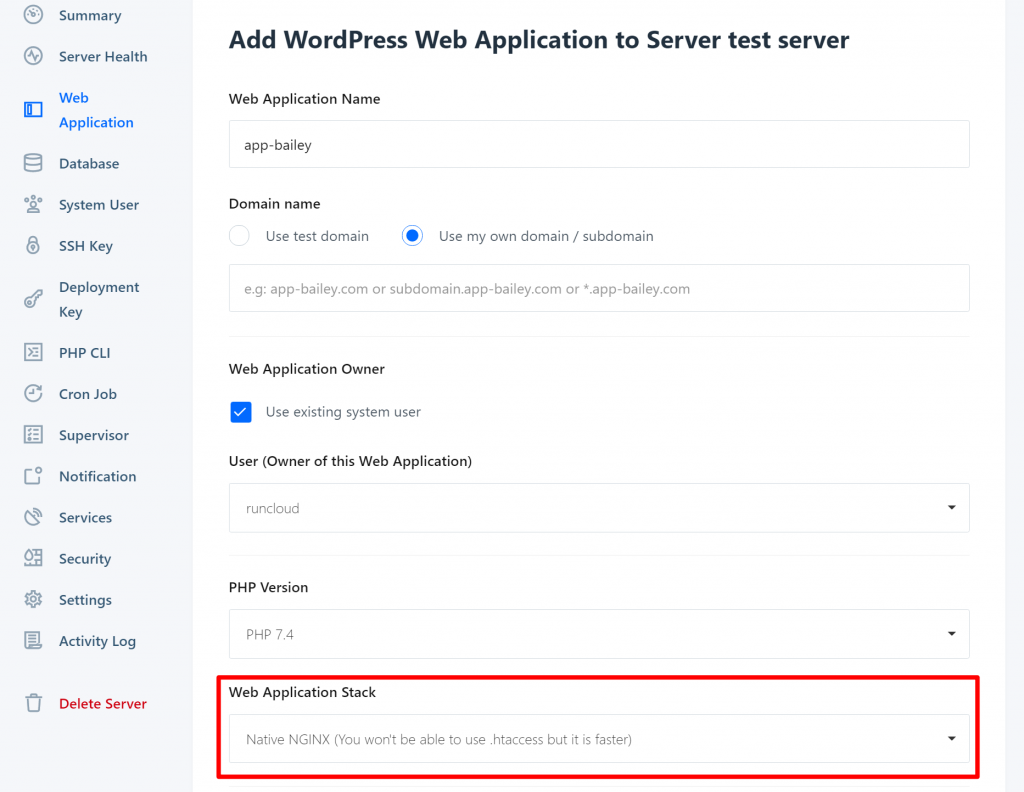
Further down, you can also enter details for your WordPress account, as well as your database user. One nice option is to use a WordPress “Canvas”, which is basically like a pre-set configuration of themes/plugins and basic settings to help you save time:
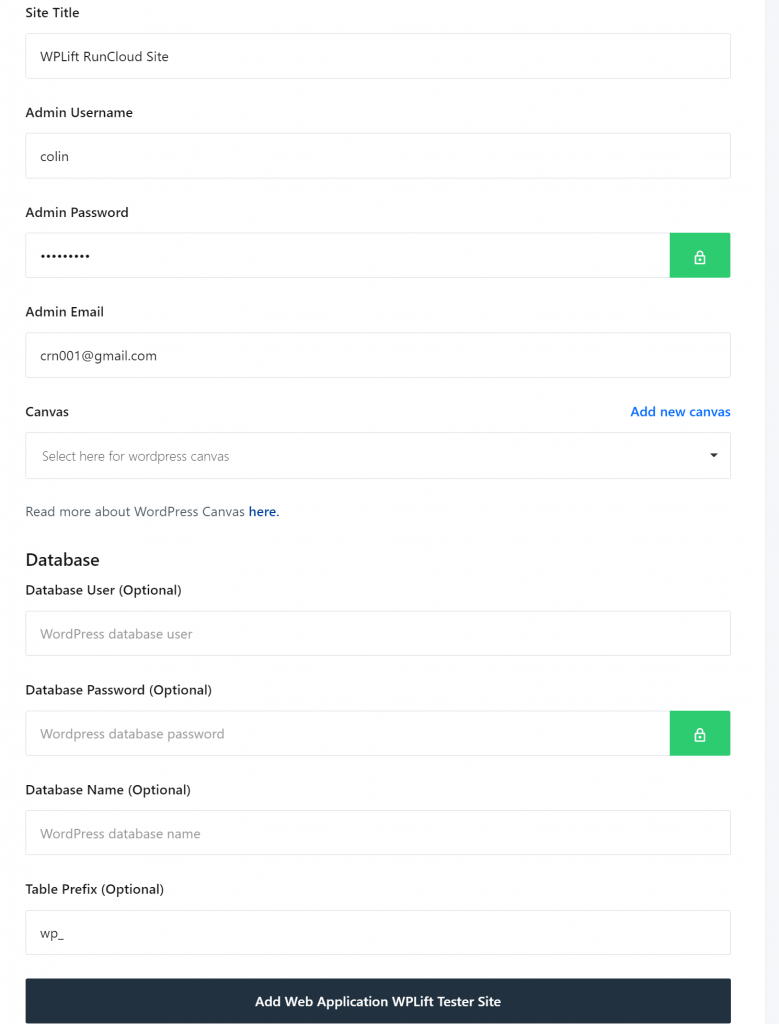
When in doubt, you can leave the setting as the default.
Once you’ve made your choices, just click the big Add Web Application button at the bottom.
And that’s it! You officially have a working WordPress site on your cloud hosting provider:
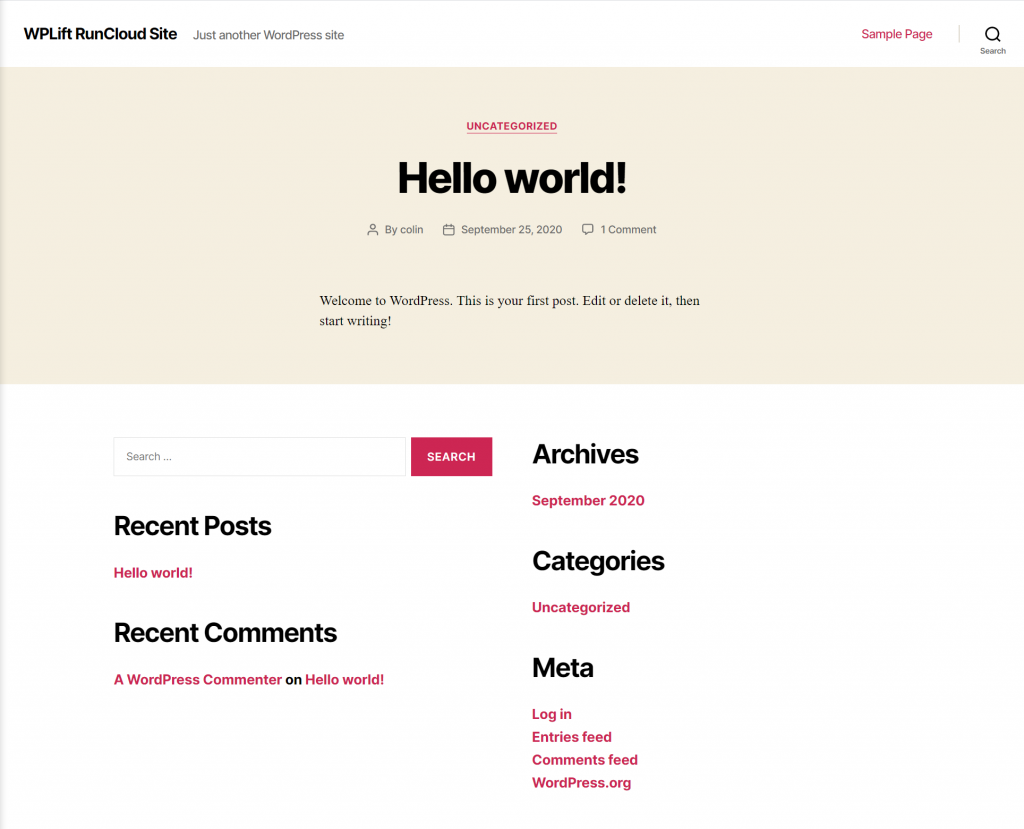
How to Manage Your Server and Applications
RunCloud gives you a bunch of settings, tools, and monitoring options at both the server and application level. There are also some WordPress-specific tools.
Server
In the Server settings, you get options to monitor the usage and health of your server. As a non-technical user, I find these really helpful to be able to quickly see whether or not I’ve overloaded my server:
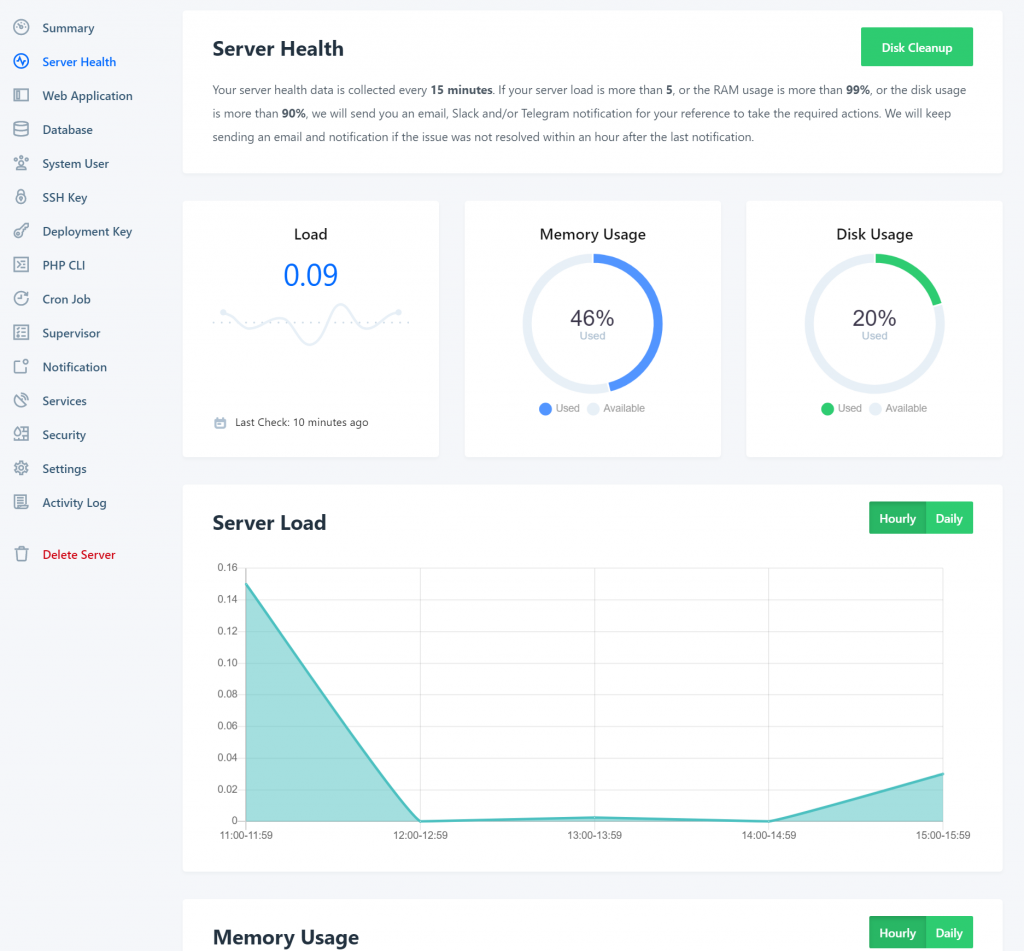
You can also see the many options on the side that let you manage various parts of your server, like your Cron jobs and databases.
If you want to make it easier to manage databases, you can also install phpMyAdmin as its own web application.
Application Settings
As a non-developer, I find the WordPress application settings to be much more interesting.
Some nice features here are:
- File Manager – lets you browse/edit all of the files on your server, just like cPanel File Manager.
- SSL/TLS – lets you install a free SSL certificate from Let’s Encrypt.
- Clone – lets you clone this WordPress site, either to the same server or to another server in your account.
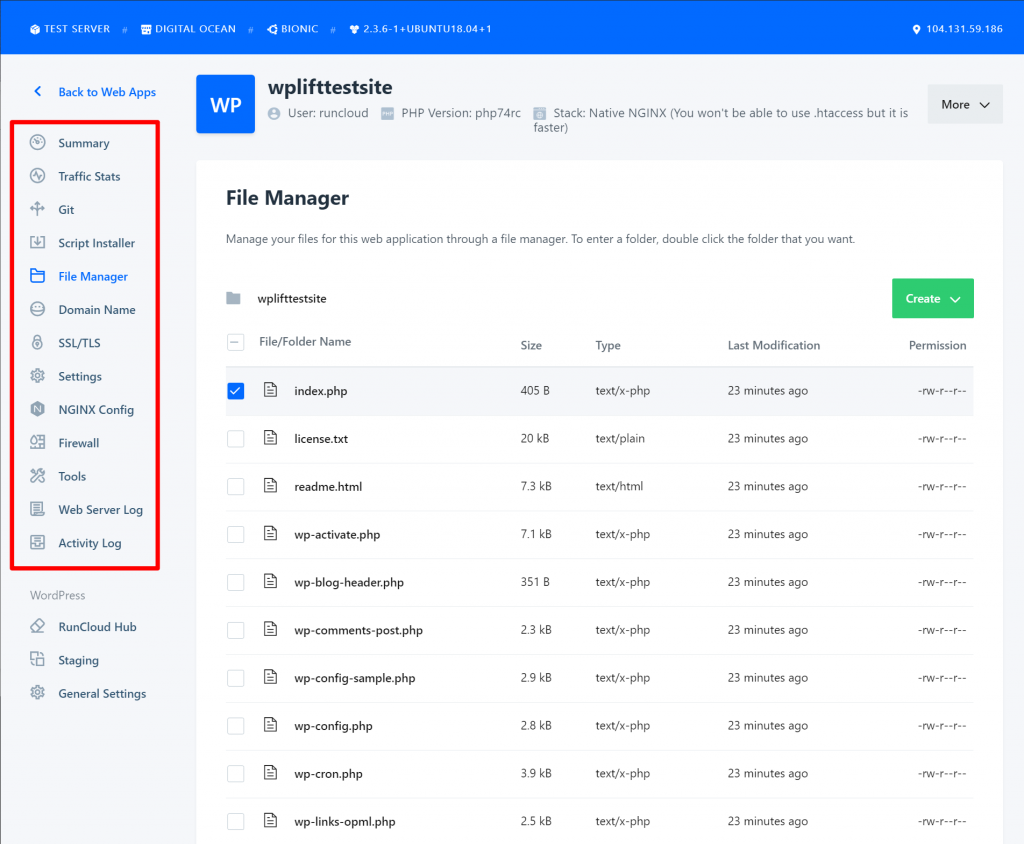
WordPress-Specific Tools
Finally, you also get some WordPress-specific tools that are available at the bottom of the list.
First off, there’s RunCloud Hub, which lets you use Nginx server-side caching purge everything as needed:
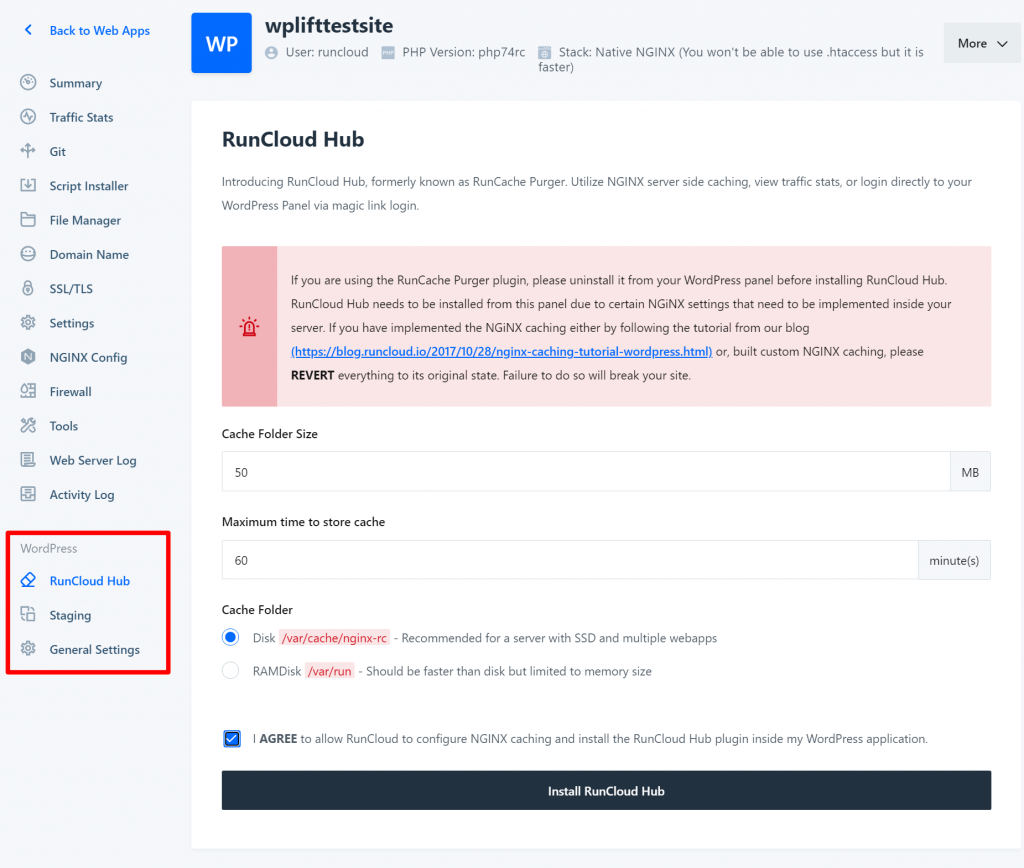
Once you enable it, you’ll be able to purge your cache from the RunCloud dashboard. RunCloud will also install a companion WordPress plugin that lets you configure and purge the cache from your WordPress dashboard, which is super handy:
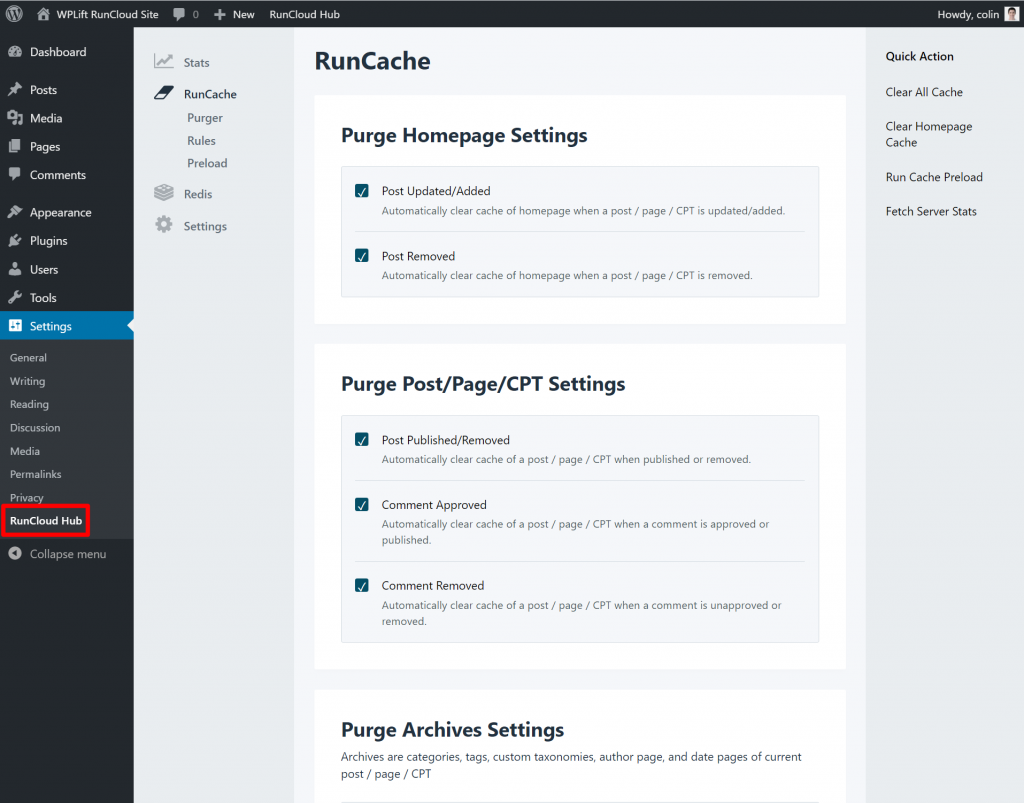
It also gives you the option of viewing server stats from inside your WordPress dashboard.
Second, there’s the Staging tab, which lets you create a staging site just like managed WordPress hosts offer. You could also just manually clone your site to create a staging site, but the advantage of the dedicated staging feature is that it gives you more options for deploying your staging site back to production because you can merge staging and production instead of overwriting them.
What About Backups?
RunCloud does offer a feature to easily back up your site to an off-server location. However, it’s an extra fee. You get 30 GB of backup storage for free and then you’ll pay $0.03/day per backup instance.
For example, if you want to have three backup instances, you’d pay $2.70 per month.
RunCloud Pricing
RunCloud offers a 5-day free trial (no credit card required) that you can use to test out the service and follow this tutorial.
From there, there are three different plans, as well as a limited (and unlisted) free plan. Each plan has different features and limits.
If you only need a single server, you can pay $8 per month. This allows unlimited websites, but only one WordPress staging site.
If you want unlimited servers, you can upgrade to the $15 per month plan.
Here are the full details on the pricing plans:
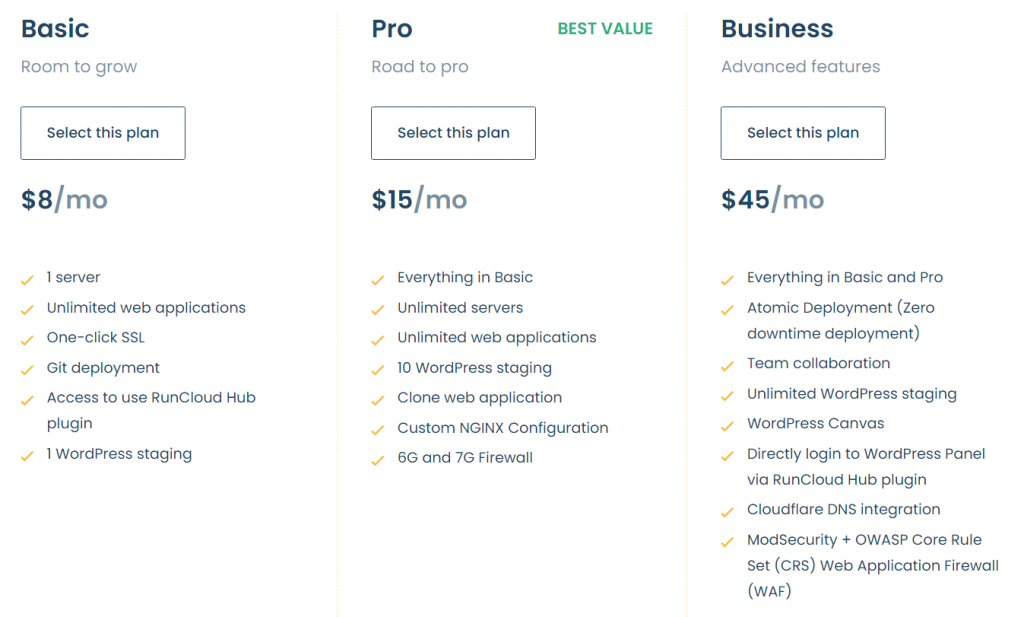
You’ll also get two months free if you opt for annual billing.
Final Thoughts
Overall, I enjoyed playing around with RunCloud. It has a nice interface while not skimping on tools and features.
Previously, I had been using SpinupWP because I preferred its interface. However, given that RunCloud is a good bit cheaper, I’m thinking of making the switch from SpinupWP to RunCloud. Of course, GridPane is also another good option, though it’s a bit more expensive.
Personally, I prefer RunCloud to GridPane as a non-developer. However, I know a lot of people prefer GridPane, so I think this really just comes down to personal preference and the specific tools that you need. I wasn’t a fan of GridPane’s interface, though everything else about it was great.
Go to RunCloud
If you liked this post, be sure to check out our roundup of the five best WordPress hosting control panels for cloud hosting. And again, we’ve also previously written reviews/tutorials for two of our favorite panels. Check them out below:
Do you have any questions about using RunCloud with WordPress or our RunCloud review? Ask away in the comments!
Keep reading the article at Learn WordPress with WPLift. The article was originally written by Colin Newcomer on 2020-09-30 06:00:17.
The article was hand-picked and curated for you by the Editorial Team of WP Archives.

